Artists at Work: Lita Albuquerque
by Steffie Nelson
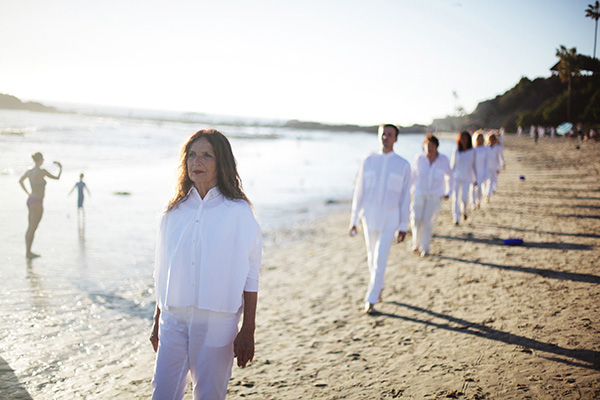
Lita Albuquerque, An Elongated Now, 2014, Laguna Beach, California, courtesy of the artist and Peter Blake Gallery
Throughout a four-plus decade career, the Malibu-based artist Lita Albuquerque has engaged in an ongoing, epic dialogue between earth and sky—from early desert installations like Spine of the Earth (1980), a “terrestrial painting” invoking the four directions on a dry lakebed in the Mojave; to Sol Star (1996), which mapped the constellations over the Pyramids of Giza with circles of the pure ultramarine blue pigment that would become her signature, the traditional North African color an homage to her own girlhood in Tunisia; to Stellar Axis (2006), an installation on the ice in Antarctica, her most ambitious project to date and the largest contemporary artwork ever created at the South Pole.
However, last year’s An Elongated Now (2014), a performance piece on Laguna Beach featuring a procession of hundreds of white-clad participants being led across the sand, seems to have pointed to a shift in direction. With two shows currently on view in Los Angeles, Embodiment at Kohn Gallery through March 5 and 20/20: Accelerando at USC’s Fisher Museum until April 10, this profoundly cosmic artist is exploring the process of becoming embodied, through the mediums of paint and film. Over espresso at Kohn Gallery one recent afternoon, we talked about the alchemical properties of her new work, the meaning of the moon landing, and how it feels to finally come down to earth.
Steffie Nelson: The titles of the paintings in your Embodiment show all reference acceleration, with names like Aether Acceleration, Light Acceleration, etc. How are they connected to the 20/20: Accelerando film and sound installation?
Lita Albuquerque: The shows were conceived and executed in parallel with one another, so one contextualizes the other. And both shows are brand new work, but they’re really on the continuum of a trajectory I started a long time ago. In the case of Embodiment, I had done a series of paintings in the past called Auric Field, with white gold or yellow gold discs on a black background inscribed with the Fibonacci sequence—a mathematical formula existing in all growth patterns, from the human cell to intergalactic space. 20/20: Accelerando evolved from a text I’d written in 2003 about the human experience of falling to Earth, of becoming embodied.
I believe ideas travel around until they find the right host, and if the host is ready they’ll enter. As a creative person—as a human being, really—it’s about being open and receiving the vibrational quality of what is occurring in the time-space continuum. And for me right now, in terms of the vibratory quality of color and how it affects the body, I really wanted to do something with a rose color. So that’s the inspiration behind these paintings—to really explore this color and the vibratory quality of the pigments and how they affect the viewer. To me, these paintings are perceptual accelerators if you take the time to use them. You could easily just walk in and walk out, but if you spend the time in front of them, they have this function.
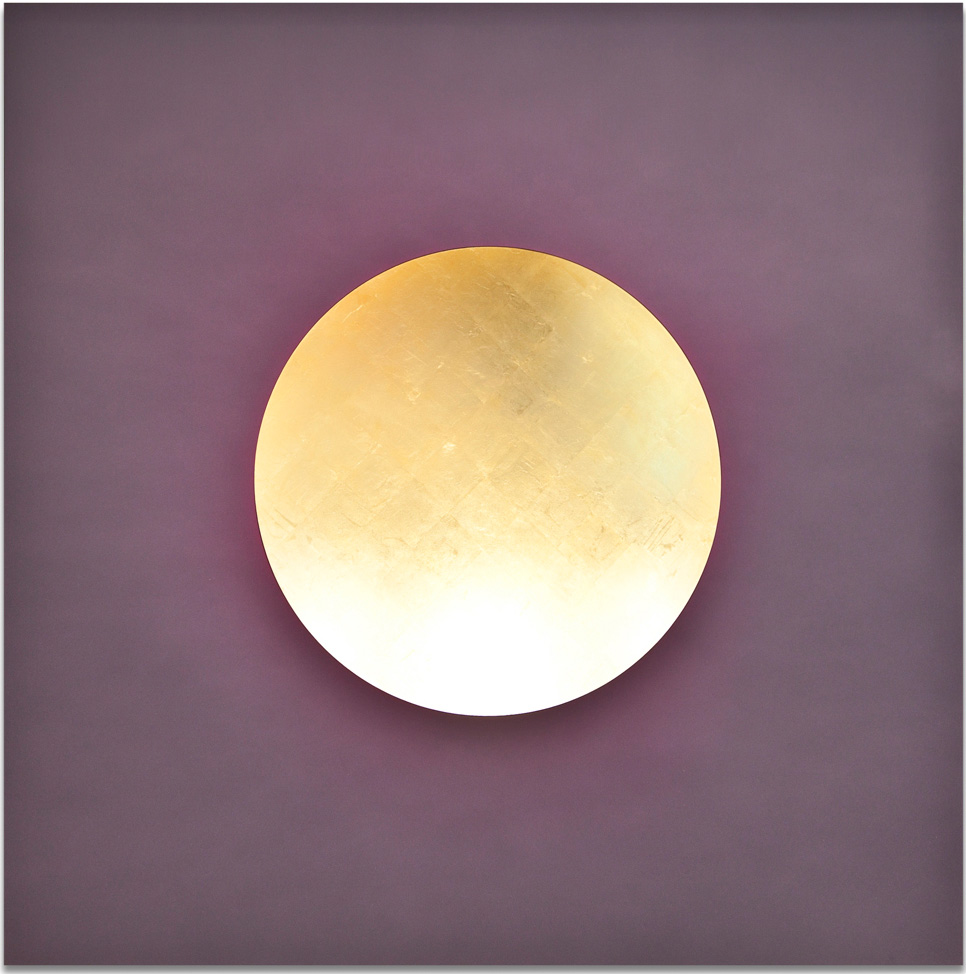
Lita Albuquerque, Onoki Acceleration, 2016, pigment on panel and 24K gold leaf on resin, 60 x 60 in., courtesy of the artist and Kohn Gallery
SN: The density of the colors and the luminosity of the discs are mesmerizing. Does the gold have a special significance?
LA: It’s very elemental: Solar light and lunar light. Both the pigments and the gold are pure materials, and the geometry is simple and minimal, so I feel that in that simplicity it becomes alchemical. The gold and the color and the shape are very much about shifting the viewers’ perception. I did a tremendous amount of research about the pigments for this because it was a new color for me. I wanted it to just be about rose, but there’s a lot of indigo in here and a few kinds of violets. I’ve done some iridescent powders in the past but not like this. I really wanted to bring in a corporeal idea of the body, so it was an interest in coming to earth. [laughs] And it’s the same with the film. Here the embodiment is an object, and in 20/20: Accelerando it’s a being.
SN: Tell us about this being, who is portrayed in the film by your daughter, Jasmine Albuquerque.
LA: This character, Elyseria, is a 25th century female astronaut whose mission is to teach the inhabitants of the planet about their relationship to the stars, which is really about light. She comes into the year 6,000 B.C. to bring this interstellar consciousness. So in the scene where she is teaching dances to the medicine man character, those dances become part of their ritual on planet earth.
She is really here to retrieve a memory. There’s a line in the film—“I was told that the water on planet earth is made of tears, of tears from those beings who died trying to remember,”—because I think we have been in a long sleep. So it’s kind of a mythical story. But in the way I originally wrote the piece, which I’m hoping to finish as a feature film, she goes on to other times to help with the accelerating of consciousness—for instance, to Egypt of 3,000 B.C. to help with the building of the pyramids as astronomical instruments.
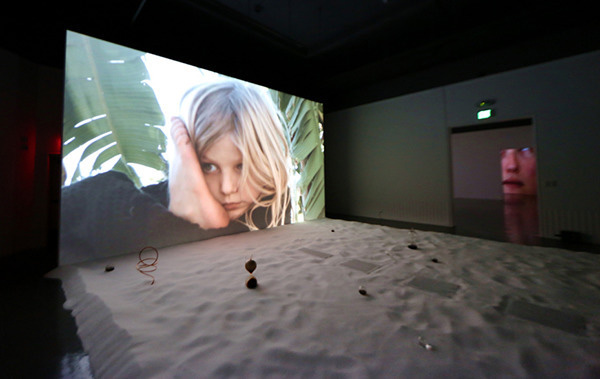
Lita Albuquerque, 20/20: Accelerando, 2016, three channel video, color, sound, installation at USC Fisher Museum
SN: You’ve described the sites of various installations as “lightning rods for the archaeology of culture.” Obviously that applies to Egypt, where you did the Sol Star piece in 1996. What do you hope to tap into in these places?
LA: There are certain energies in certain spots of the earth that connect you to higher dimensions. The Egyptian culture is completely about the relationship of the earth, sky, and stars. There, they somehow figured out a way of containing and transmitting energy through their aesthetic, through the sculptural works and the architecture—don’t ask me how!—so that now, that knowledge is being transmitted 3,000 years later. I can go around and hear things and sense certain ideas. They were able to materialize, to bring into matter, certain metaphysical ideas; there are resonances that can be accessed. I think it’s because it’s all based on the cosmos and sacred geometry.
Somehow—to answer your question—my ultimate goal is to get to that knowledge. If we can perceptually align ourselves to the stars we can access and be open to that knowledge. I’ve never even verbalized it but I realize that that’s what it is. If the body can be aligned the way the pyramids are, as a way of accessing the perceptual field, then it becomes about pattern recognition; and in that pattern recognition we get that access. One of the first spiritual laws is Hermes’s concept of “As above, so below,” and I think if the pattern of the stars aligned with the pattern of your body—I’m still exploring this, but once you get this, you’re never lonely. You’re so connected. It’s kind of big, doing all this in art.
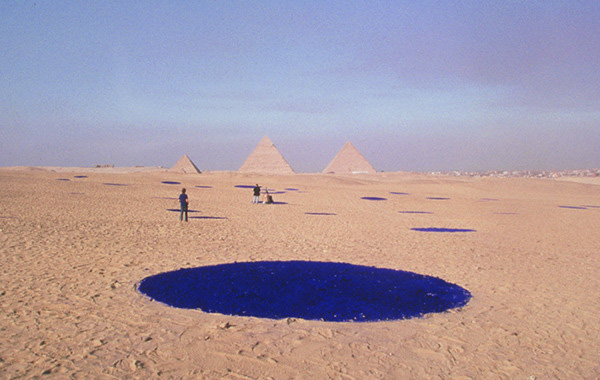
Lita Albuquerque, Sol Star, 1996, Giza Plateau for the 6th Cairo International Biennale, Cairo, Egypt, courtesy of the artist and Kohn Gallery
SN: Do you consider your work spiritual?
LA: It is, obviously, but it’s not something I seek. I’m interested in locating us as a humanity and as a planet in the cosmos. Who are we? Not just as individuals here, in our own lives, but what is the planet in relationship to all that? Where are we in relationship to that? It’s a way of navigating. I’ve always had this feeling of navigating the planet. It’s important to think in terms of that relationship, as a way of connecting.
And talk about lightning rods! In 2014, I traveled to the Yucatan with my graduate students from Art Center [College of Design]. I was interested in the relationship of Michael Heizer’s work—through the influence of his father, who was an archaeologist— to places like Teotihuacan, the Temple of the Sun of the Moon outside Mexico City, which I’d never been to. And we went to Chichen Itza, and I found out that they built the pyramids around these cenotes, which are sinkholes about 50 feet down that you can swim in. I had an incredible experience in one of these, which I called an out of body experience. I was invoking the date that it was—June 16, 2014—and I was floating in the water in this immense grotto, looking up at the roots of a tree, through this hole, to the sun; and all of a sudden I go way, way up. And then it took forever; and I had this garment filled with galaxies, and it took me forever to go down to the Milky Way, andsomehow I found the solar system and planet earth and the horn of the Yucatan. It was spectacular.
SN: Conceptually, you seem aligned with both the land art and the light and space movements. Do you feel connected to those artists?
LA: Very much so. Certainly with [James] Turrell, there’s a real similarity there in terms of our passions and our desires. We both have a great love of the sky, and try to bring an awareness of the sky and light to the viewer. In Roden Crater he’s doing it in an extraordinary way that’ll transcend time. He also uses color in a different way, because it’s through light while mine is through pigment. Another artist I feel a kinship with is Walter DeMaria, especially with the Lightning Field; the poles seem to be such a connection between earth and sky. So yes, I feel very connected.
Michael Kimmelman writes about land art as contemporary versions of ancient sites, and the influence really does come from Mesoamerica and Egypt. Being from North Africa, I think I have this deep love and understanding of the ancient. I think it’s in my blood.
I actually believe that one of the first land artists is Yves Klein, who lived in Nice, across the Mediterranean, even though he never worked in the environment. People always ask me about him because we both are known for using blue—and, first of all, his color blue is different than mine. But the reason I say that he is one of the first land artists is because way before we landed on the moon and came back with the image of Earth that is so ubiquitous, he started a school of sensitivity to the planet. He had a dream where he was signing the back of the sky. So whenever people ask me about Yves Klein, I say that I’ve taken that color into the outdoors, which he did not. But he started thinking about the planet and the environment long before we were outside of it, looking back.
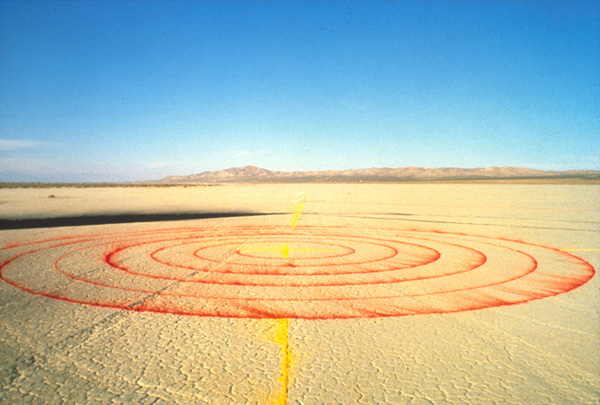
Lita Albuquerque, Spine of the Earth, 1980, El Mirage Dry Lake Bed, Mojave Desert, California, courtesy of the artist and Kohn Gallery
SN: I know you’ve cited the moon landing as a pivotal moment for you as an artist and a person. Could you explain its significance for you?
LA: That was a very early jumping off point for my practice. It was 1969 and I was just beginning; I hadn’t declared myself as an artist yet. I was in Tunisia visiting my mother and I was driving in the desert with a friend, and before we reached the Sahara our car broke down. We could see a farmhouse and inside that farmhouse happened to be friends of his. They had a television set and inside that television set, as we arrived, was the landing on the moon. So it was one of those incredible moments that totally altered my consciousness.
Buckminster Fuller talked about his experience in the science community and how it was only once he was outside that community that he was able to get his ideas. Once you’re outside the thing you can really see the thing. Well, once we’re outside Earth we can see it, and now we understand that we are in that planetary system. It’s a revolution in perspective, completely, as important if not more important than the one point perspective during the Renaissance. It’s a paradigm shift, and to have experienced it in that dramatic way it was just embedded in me. And that’s when I stared doing these practices of saying the time and date and projecting myself in outer space and then coming back down. I did years of that before I really got it.
SN: This seems like your own personal form of meditation. Can you remember the first time you did it or how it impacted you?
LA: The whole thing was such a progression that I don’t know if I can answer that. I started doing automatic writing, focusing on the time and date. [New Age author] Jane Roberts did a whole series called the Seth books that started me on it in the early ’70s. Then I started doing the same things in terms of location. I still remember March 15, 1988, swimming in a pool in Jaipur, India, at 3:30pm. I still remember May 8, 1988, on a donkey, going into the Valley of the Kings in Egypt. Because what I would do is state the date, time, and location, and then I would project my imagination. So I projected being at the outer reaches of all known universes and then coming back down and I would see all the galaxies, comets, until I could see the planet half in dark, half in light; and then I could see the continent, closer and closer, and the grid of Los Angeles. I would do that 30 or 40 times a day. I guess it anchored me, but I don’t know why I started doing it. I think one of the reasons—and it could be unconscious—is that as a child I lived in Tunisia and then all of a sudden I was plucked out of there and it was such a shock. So maybe it was a way of anchoring on that level.
SN: In a sense you’re almost freezing time or standing within it. You’ve often said that light is a carrier of information, but isn’t it also the carrier of time? I find it fascinating that you’ve cultivated this intimate relationship with time, which certainly not everyone does.
LA: One of my colleagues jokingly said, “You’re the queen of the here and now.” The thing is, we don’t know what time is yet. Scientists don’t know what light is yet. They talk in terms of waves and particles but it’s just so mysterious. There is this acceleration that’s happening, probably on the level of light. And since we are light, and since everything in the cosmos is light, everything is sensing this kind of acceleration. This is my intuition as an artist, not as a scientist, and that’s what I want to activate. I mean, maybe what’s beyond the cosmos is light, so maybe we’re moving into that awareness. That’s the dimension beyond everything.
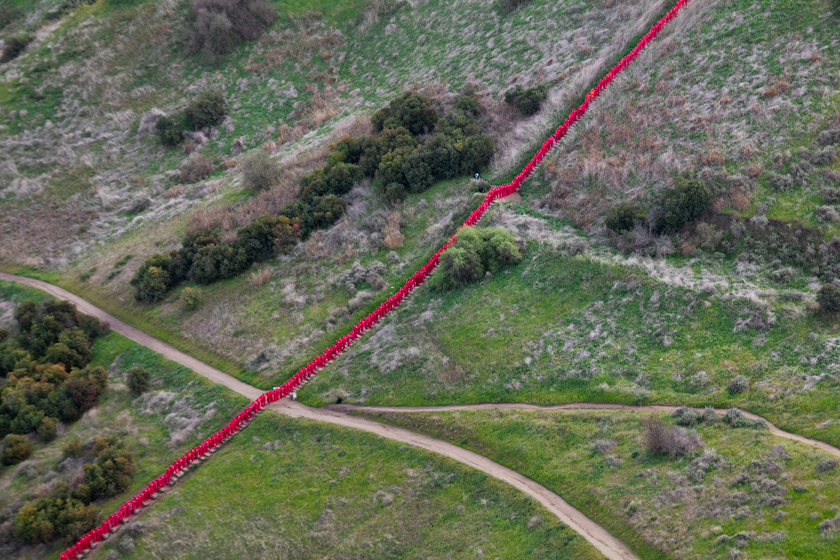
Lita Albuquerque, Spine of the Earth 2012, 2012, Getty Museum Pacific Standard Time Performance Festival, courtesy of the artist and Kohn Gallery, photo: Michael Light
SN: It’s interesting that we’re talking about time and acceleration, because one note I made has to do with patience. Your projects don’t happen quickly. In some cases you plan them years in advance, and they’re very labor intensive and deliberate. You’re not going for the quick impact.
LA: I know! It’s so funny because I never thought of myself as that kind of a person. I am very spontaneous but there’s this other driving force. Art always amazes me because it’s so much a dialogue with the work and you can’t control it. What’s interesting about these large projects I do is the risk taking, because there’s so much unknown and all these factors that you can’t really control—the weather, for one. I like that because things occur that you then have to dance with and see what it is as opposed to what you think it should be. You’re always on your toes. The pieces themselves end up being very simple, visually, but it’s very complex and it involves people and the environment and time. It’s life! It’s still art, and it’s not quite theater; it’s an engagement and it engages the viewer. Marcel Duchamp used to say—I’ll never forget, it was something I learned in my first art history class when I was 17—that the work of art is not complete until the viewer sees it.
SN: Yet Stellar Axis, for which you went to Antarctica for a month on a grant from the National Science Foundation (NSF), was destined to be seen by very few, although it was the subject of a Nevada Museum of Art exhibition and a beautiful Rizzoli monograph. Could you describe this installation?
LA: It was a reverse sky on the ice, corresponding to the 99 brightest stars. The white ice was the dark night and the ultramarine blue spheres were the light of the stars, so that’s kind of a shift of perception. I was doing a mirroring of the stars above and when I worked with Simon Balm, the astronomer on the project, to pick which stars to depict, I chose 99 of the brightest stars in the sky, not necessarily constellations. The important configuration at the South Pole is the Southern Cross, and we did include it.
SN: Where did the original idea come from?
LA: It was inspired by a spontaneous image that came to me, of a planet that had nothing on it but gold-tipped pyramids on its surface, all aligned to the stars above. That was the image that triggered it off and I thought “wow, this is amazing, and this is what I want to do—not pyramids, but points of stars all over the earth, like star shadows or reflections.” And I started thinking about that and then on an airplane I thought of doing that just at the North and South Poles, as a way of linking them through the axis of the earth. The challenge was, how to get to the poles? I found out about the National Science Foundation and their artist grant program, and I applied and received it.
At that time I thought I could do simultaneous projections of the stars, linking them conceptually through the axis of the earth, as if a shaft of light was coming through its center. Of course, this is impossible because you can’t go there in the winter. And then it evolved into the reality, and I’m talking about process now—so it’s like, what are you allowed to use, in terms of material? In Egypt I used pure powdered blue pigment on the sand; here if I used powdered pigment, it would turn black. So I did all this research and the physical installation ended up being 99 blue spheres of different sizes, ranging from 10 inches to 48 inches, covering a diameter of 400 feet. I initially wanted them huge and in 90-degree alignment to the stars, which meant they would cover kilometers.
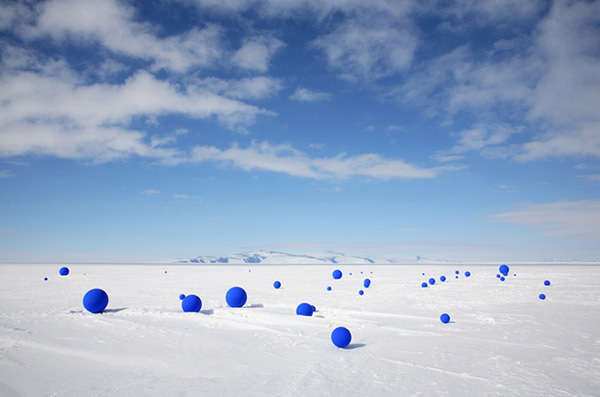
Lita Albuquerque, Stellar Axis, 2006, Antarctica, courtesy of the artist and Kohn Gallery
SN: What was the installation process like?
LA: There were 24 hours of daylight and we worked from 8pm to 6am. The halves of the spheres had to be assembled on the ice, with 3 inch diameter poles a meter long stuck in the ice. A few days it was minus-40 degrees and I almost passed out from the cold. Other times I didn’t have my jacket on. Mostly, it was amazing weather. When I needed to cover footprints with snow, it snowed. We were very lucky.
SN: How did the environment compare to your expectations?
LA: I really wanted to have an experience of complete wilderness and it’s impossible; the NSF wants to make sure you are safe. But then I found out how amazing the community was because everyone wants to be there and has this love of the unknown and adventure. It was exhilarating just being there the whole time, and it wasn’t just me. Everyone was exhilarated. It has something to do with the pristineness of it. The particles of light were so pure that it just felt like they went right into your system and transformed you. Everybody asked me, “did you get lonely?” Not once! I didn’t miss anything or anyone. It was very strange. One of my daughters said, “it’s because you went to heaven.” And when I came back here, I stepped off the airplane and it felt like I was coming into a soup. It took me about a month to readjust.
SN: And Werner Herzog was there at the same time?
LA: Yes! I was so thrilled to be there the year he was there. I met him in Colorado when we received the grants. He is my idol, my favorite director. It was fantastic. We became good friends. His persona is very different from who he is. I don’t know if he liked being there but I think the film he made, Encounters at the End of the World, is very representational of being there.
The other thing about being there is that you’re so conscious of your dependence on other people; you really get that you’re part of a system, whereas here we think we’re just individuals walking around. There, because of the Antarctica Treaty, which states that everything you bring to the continent has to be taken out, you have 20 different kinds of recycling. You are so aware of your consumption—what we consume and excrete and all that, and how we have to take care of it. Here, we forget the interconnectedness of everything. There, you die if you’re not conscious of what you have to do to survive.
SN: I love the fact that the concept of the 99 brightest stars continues in 20/20: Accelerando, with the singing of the names of the stars.
LA: There’s definitely a continuum. In fact. that’s how 20/20: Accelerando came about. I always wanted to have this symphonic work about the names of the 99 brightest stars we had reflected on the ice for the Stellar Axis exhibition, but when I had the show in Nevada in 2014 they wanted to do more of an archival show. So when Selma Holo, the director of the Fisher Museum, approached me, I told her I thought it was going to be a Stellar Axis show and would have that component. And then I decided I wanted something with a more masculine energy in the music, a sound that depicted the stars both with beauty and power, and I found a great collaborator in Robbie C. Williamson, who then brought in Cassandra Bickman, who invented the tonal language in the film. So yeah, it keeps building and I’m hoping that through this we’ll be able to get funding to make a larger film that will keep the story going. This is chapter one.
SN: The story is about bringing an interstellar consciousness down to earth, but in a way the whole project feels like you, too, are coming down to earth, or becoming embodied, after so many years of projecting yourself into the cosmos.
LA: Somebody said to me recently, “you do so much collaboration, you’re not a lone artist in the studio.” And I said “no, I do like to be around other people, but I spent an incredibly lonely childhood and in that aloneness I came up with this other stuff!” And now it’s only recently that I can accept that I’m part of the human race. [laughs] It actually was through making the film. I thought, “Oh, I’m a human!” Really! I know that sounds totally ridiculous but I really feel like, “ok, I know what it’s like to be a human: it’s about connecting to other people.” I thought I had to do it all myself. So now it’s a great joy being with other incredible people and seeing how great we are together.